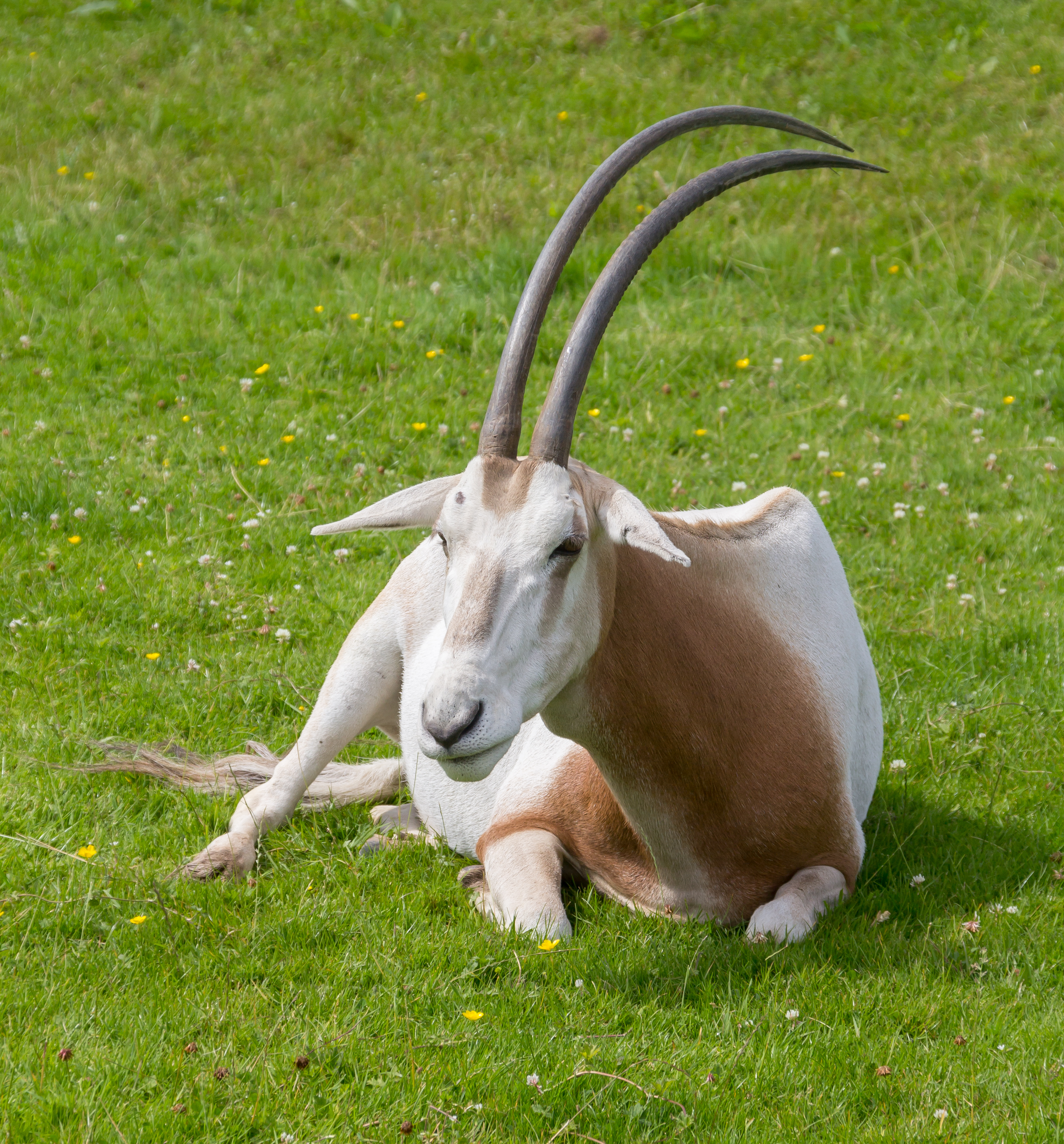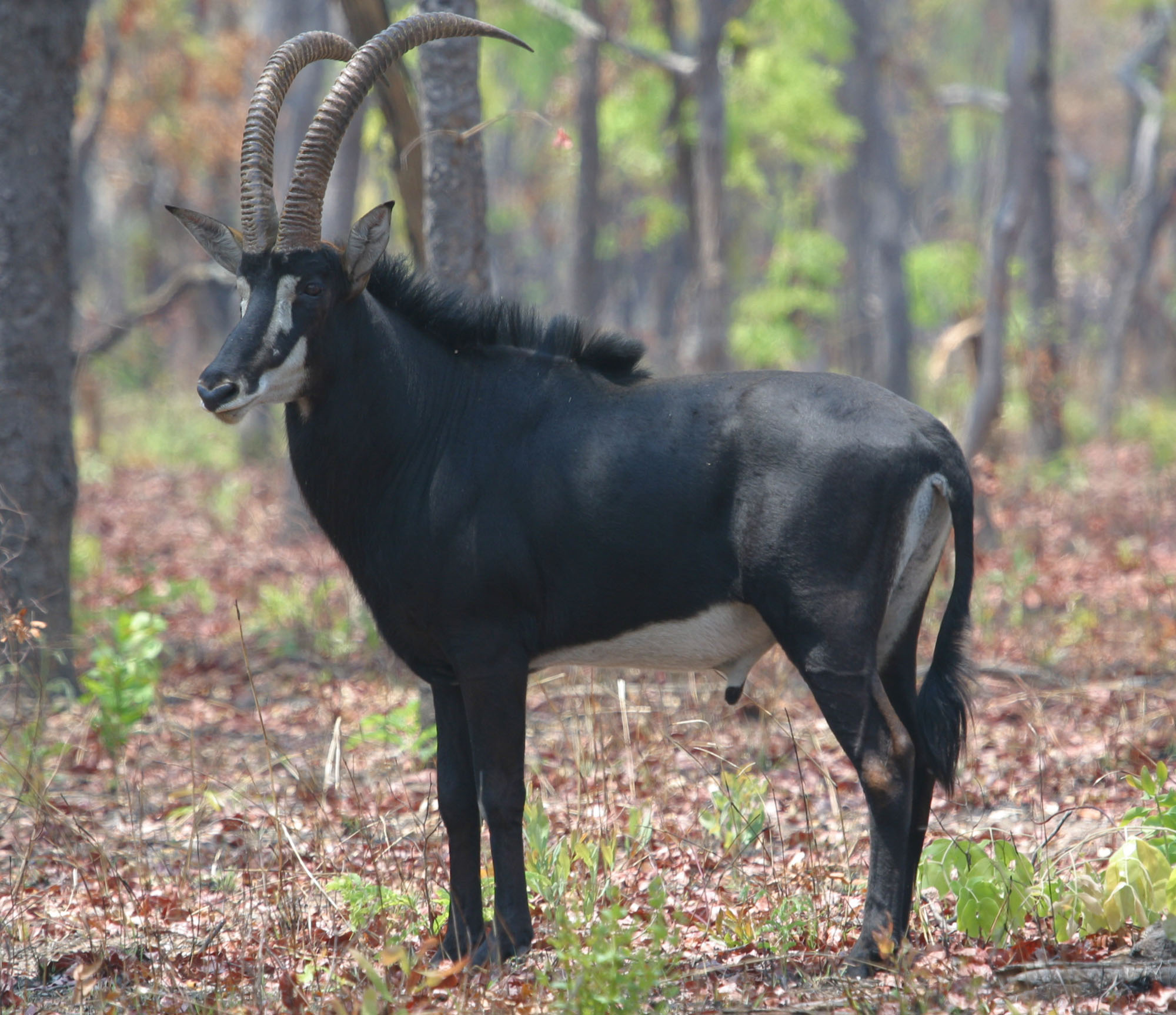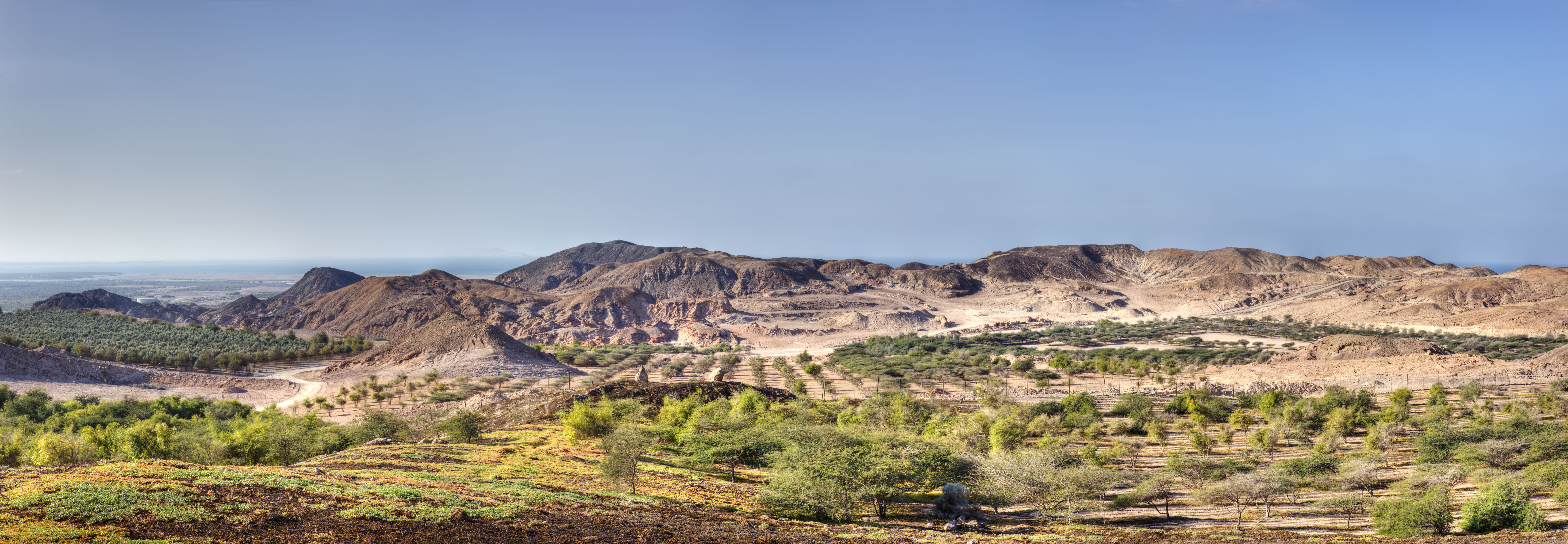|
Oryx
''Oryx'' ( ) is a genus consisting of four large antelope species called oryxes. Their pelage is pale with contrasting dark markings in the face and on the legs, and their long horns are almost straight and annulated. The exception is the scimitar oryx, which lacks dark markings on the legs, only has faint dark markings on the head, has an ochre neck, and has horns that are clearly decurved. All oryx species prefer near-desert conditions and can survive without water for long periods. The Arabian oryx was only saved from extinction through a captive-breeding program and reintroduction to the wild. The scimitar oryx, which was listed as extinct in the wild, also relied on a captive-breeding program for its survival.Database entry includes justification for why this species is listed as extinct in the wild. Etymology The term "oryx" comes from the Greek word ''óryx'' meaning "pickaxe", because its long and pointed horns look similar to the tool's end. The Greek plural f ... [...More Info...] [...Related Items...] OR: [Wikipedia] [Google] [Baidu] [Amazon] |
Arabian Oryx
The Arabian oryx or white oryx (''Oryx leucoryx'') is a medium-sized antelope with a distinct shoulder bump, long, straight horns, and a tufted tail. It is a bovid, and the smallest member of the genus '' Oryx'', native to desert and steppe areas of the Arabian Peninsula. The Arabian oryx was extinct in the wild by the early 1970s, but was saved in zoos and private reserves, and was reintroduced into the wild starting in 1980. In 1986, the Arabian oryx was classified as endangered on the IUCN Red List, and in 2011, it was the first animal to revert to vulnerable status after previously being listed as extinct in the wild. It is listed in CITES Appendix I. In 2016, populations were estimated at 1,220 individuals in the wild, including 850 mature individuals, and 6,000–7,000 in captivity worldwide. Etymology The taxonomic name ''Oryx leucoryx'' is from the Greek ' (gazelle or antelope) and ' (white). The Arabian oryx is also called the white oryx in English, ' in Hebrew, ... [...More Info...] [...Related Items...] OR: [Wikipedia] [Google] [Baidu] [Amazon] |
Oryx Leucoryx
The Arabian oryx or white oryx (''Oryx leucoryx'') is a medium-sized antelope with a distinct shoulder bump, long, straight horns, and a tufted tail. It is a bovid, and the smallest member of the genus ''Oryx'', native to desert and steppe areas of the Arabian Peninsula. The Arabian oryx was extinct in the wild by the early 1970s, but was saved in zoos and private reserves, and was reintroduced into the wild starting in 1980. In 1986, the Arabian oryx was classified as endangered on the IUCN Red List, and in 2011, it was the first animal to revert to vulnerable status after previously being listed as extinct in the wild. It is listed in CITES Appendix I. In 2016, populations were estimated at 1,220 individuals in the wild, including 850 mature individuals, and 6,000–7,000 in captivity worldwide. Etymology The taxonomic name ''Oryx leucoryx'' is from the Greek ' (gazelle or antelope) and ' (white). The Arabian oryx is also called the white oryx in English, ' in Hebrew, and is ... [...More Info...] [...Related Items...] OR: [Wikipedia] [Google] [Baidu] [Amazon] |
Arabian Oryx Reintroduction
The Arabian oryx (''Oryx leucoryx''), also called the white oryx, was extinct in the wild as of 1972, but was reintroduced to the wild starting in 1982. The initial reintroduction was primarily from two herds: the "World Herd" originally started at the Phoenix Zoo in 1963 from only nine oryx and the Saudi Arabian herd started in 1986 from private collections and some "World Herd" stock by the Saudi National Wildlife Research Center (NWRC). As of 2009, there have been reintroductions in Oman, Saudi Arabia, Israel, the United Arab Emirates, and Jordan, and as of 2013 the IUCN Red List classifies the species as vulnerable. Decline of a species The Arabian oryx was known to be in decline since the early 1900s in the Arabian Peninsula. By the 1930, there were two separate populations isolated from each other. In 1960, Lee M. Talbot reported that Arabian oryx appeared to be extinct in its former range along the southern edge of Ar-Rub' al-Khali. He believed that any oryx still exist ... [...More Info...] [...Related Items...] OR: [Wikipedia] [Google] [Baidu] [Amazon] |
Scimitar Oryx
The scimitar oryx (''Oryx dammah''), also known as the scimitar-horned oryx and the Sahara oryx, is an '' Oryx'' species that was once widespread across North Africa and parts of West Africa and Central Africa. In 2000, it was declared extinct in the wild on the IUCN Red List, but in 2023 it was downlisted to endangered, with a reintroduced population in Chad. This particular oryx is adapted to harsh desert conditions and can survive for months or even years without drinking water. A grazing animal, it derives most of its daily moisture intake from plants. The decline of the scimitar oryx population began as a result of climate change during the Neolithic period, and later it was hunted extensively for its horns. Today, it is bred in captivity in special reserves in Tunisia, Morocco, and Senegal, and on private exotic animal ranches in the Texas Hill Country, United States. In 2016, a reintroduction program was launched and currently a small herd has been successfully reintrodu ... [...More Info...] [...Related Items...] OR: [Wikipedia] [Google] [Baidu] [Amazon] |
Oryx Dammah
The scimitar oryx (''Oryx dammah''), also known as the scimitar-horned oryx and the Sahara oryx, is an ''Oryx'' species that was once widespread across North Africa and parts of West Africa and Central Africa. In 2000, it was declared extinct in the wild on the IUCN Red List, but in 2023 it was downlisted to endangered, with a reintroduced population in Chad. This particular oryx is adapted to harsh desert conditions and can survive for months or even years without drinking water. A grazing animal, it derives most of its daily moisture intake from plants. The decline of the scimitar oryx population began as a result of climate change during the Neolithic period, and later it was hunted extensively for its horns. Today, it is bred in captivity in special reserves in Tunisia, Morocco, and Senegal, and on private exotic animal ranches in the Texas Hill Country, United States. In 2016, a reintroduction program was launched and currently a small herd has been successfully reintroduce ... [...More Info...] [...Related Items...] OR: [Wikipedia] [Google] [Baidu] [Amazon] |
Oryx Gazella
The gemsbok (''Oryx gazella''), or South African oryx, is a large antelope in the genus ''Oryx''. It is endemic to the dry and barren regions of Botswana, Namibia, South Africa and (parts of) Zimbabwe, mainly inhabiting the Kalahari and Namib Deserts, areas in which it is supremely adapted for survival. Previously, some sources classified the related East African oryx, or beisa oryx (''Oryx beisa''), as a subspecies. Name The name ''gemsbok'' is from Afrikaans, which itself is from the Dutch word of the same spelling, meaning "male chamois", composed of (“chamois”) + (“buck, male goat”). The Dutch is further from German ("chamois"). Although some superficial similarities in appearance (especially in the facial pattern) are noticed, the chamois and the oryx are not closely related. The usual pronunciation in English is . Description Gemsbok are light taupe to tan in color, with lighter patches toward the bottom rear of the rump. Their tails are long and black in ... [...More Info...] [...Related Items...] OR: [Wikipedia] [Google] [Baidu] [Amazon] |
Gemsbok
The gemsbok (''Oryx gazella''), or South African oryx, is a large antelope in the genus '' Oryx''. It is endemic to the dry and barren regions of Botswana, Namibia, South Africa and (parts of) Zimbabwe, mainly inhabiting the Kalahari and Namib Deserts, areas in which it is supremely adapted for survival. Previously, some sources classified the related East African oryx, or beisa oryx (''Oryx beisa''), as a subspecies. Name The name ''gemsbok'' is from Afrikaans, which itself is from the Dutch word of the same spelling, meaning "male chamois", composed of (“chamois”) + (“buck, male goat”). The Dutch is further from German ("chamois"). Although some superficial similarities in appearance (especially in the facial pattern) are noticed, the chamois and the oryx are not closely related. The usual pronunciation in English is . Description Gemsbok are light taupe to tan in color, with lighter patches toward the bottom rear of the rump. Their tails are long and black ... [...More Info...] [...Related Items...] OR: [Wikipedia] [Google] [Baidu] [Amazon] |
Oryx Beisa
The East African oryx (''Oryx beisa''), also known as the beisa, is a species of medium-sized antelope from East Africa. It has two subspecies: the common beisa oryx (''Oryx beisa beisa'') found in steppe and semidesert throughout the Horn of Africa and north of the Tana River, and the fringe-eared oryx (''Oryx beisa callotis'') south of the Tana River in southern Kenya and parts of Tanzania. The species is listed as Endangered by the IUCN. In the past, some taxonomists considered it a subspecies of the gemsbok (''Oryx gazella''), but they are genetically distinct; the diploid chromosome count is 56 for the beisa and 58 for the gemsbok. Description The East African oryx stands just over a metre at the shoulder and weighs around . It has a grey coat with a white underside, separated from the grey by a stripe of black, with black stripes where the head attaches to the neck, along the nose, and from the eye to the mouth and on the forehead. The mane is small and chestnut-colou ... [...More Info...] [...Related Items...] OR: [Wikipedia] [Google] [Baidu] [Amazon] |
Antelope
The term antelope refers to numerous extant or recently extinct species of the ruminant artiodactyl family Bovidae that are indigenous to most of Africa, India, the Middle East, Central Asia, and a small area of Eastern Europe. Antelopes do not form a monophyletic group, as some antelopes are more closely related to other bovid groups, such as bovines, goats, and sheep, than to other antelopes. A stricter grouping, known as the true antelopes, includes only the genera '' Gazella'', '' Nanger'', '' Eudorcas'', and '' Antilope''. One North American mammal, the pronghorn or "pronghorn antelope", is colloquially referred to as the "American antelope", despite the fact that it belongs to a completely different family ( Antilocapridae) than the true Old-World antelopes; pronghorn are the sole extant member of an extinct prehistoric lineage that once included many unique species. Although antelope are sometimes referred to, and easily misidentified as, "deer" ( cervids), true ... [...More Info...] [...Related Items...] OR: [Wikipedia] [Google] [Baidu] [Amazon] |
Species Reintroduction
Species reintroduction is the deliberate release of a species into the wild, from captivity or other areas where the organism is capable of survival. The goal of species reintroduction is to establish a healthy, Genetic diversity, genetically diverse, self-sustaining population to an area where it has been extirpated, or to augment an existing population. Species that may be eligible for reintroduction are typically Threatened species, threatened or endangered in the wild. However, reintroduction of a species can also be for pest control; for example, wolves being reintroduced to a wild area to curb an overpopulation of deer. Because reintroduction may involve returning native species to localities where they had been extirpated, some prefer the term "reestablishment". Humans have been reintroducing species for food and pest control for thousands of years. However, the practice of reintroducing for conservation is much younger, starting in the 20th century. Methods for sourcing i ... [...More Info...] [...Related Items...] OR: [Wikipedia] [Google] [Baidu] [Amazon] |
Captive Breeding
Captive breeding, also known as captive propagation, is the process of keeping plants or animals in controlled environments, such as wildlife reserves, zoos, Botanical garden, botanic gardens, and other Conservation biology, conservation facilities. It is sometimes employed to help species that are being threatened by the effects of human activities such as climate change, habitat loss, Habitat fragmentation, fragmentation, overhunting or fishing, pollution, predation, disease, and parasitism. For many species, relatively little is known about the conditions needed for successful breeding. Information about a species' reproductive biology may be critical to the success of a captive breeding program. In some cases a captive breeding program can save a species from extinction, but for success, breeders must consider many factors—including genetic, ecological, behavioral, and ethical issues. Most successful attempts involve the cooperation and coordination of many institutions. Th ... [...More Info...] [...Related Items...] OR: [Wikipedia] [Google] [Baidu] [Amazon] |
Sir Bani Yas
Sir Bani Yas () is a natural island located southwest of Abu Dhabi, the capital of the United Arab Emirates. It lies offshore from Jebel Dhanna, which serves as a crossing point to other islands such as Dalma. Sir Bani Yas is from north to south and from east to west, making it the largest natural island in the United Arab Emirates. Located just off the shore of the western region of Abu Dhabi, Sir Bani Yas was originally home to Arabia's largest wildlife reserve. Spanning over , the reserve was established in 1977 by Sheikh Zayed Bin Sultan Al Nahyan. Due to decades of conservation work and ecological investment, it is now home to thousands of large free-roaming animals and several million trees and plants. A bird sanctuary as well as a wildlife reserve, Sir Bani Yas showcases nature through activities such as adventure safaris, kayaking, mountain biking, archery, hiking and snorkeling. History The name ''Sir Bani Yas'' originates from the Bani Yas tribe, who first inhab ... [...More Info...] [...Related Items...] OR: [Wikipedia] [Google] [Baidu] [Amazon] |







